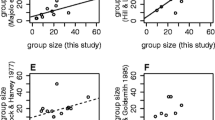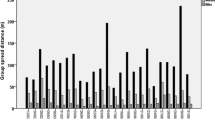Abstract
When plotted along a gradient of population density, the mean group size in populations of several primate species has a unimodal distribution, i.e., mean group size is greater at intermediate population densities than at higher or lower population densities. In this study I present a mathematical model to clarify the cause of this relationship. Population density is assumed to affect group size by enhancing between- or within-group competition and by changing the number of neighboring groups around each group. The mean group size is predicted to decline as population density increases above a critical value, owing to the increasing number of neighboring groups.


Similar content being viewed by others
References
Alexander RD (1974) The evolution of social behavior. Annu Rev Ecol Syst 5:325–383
Cheney DL (1987) Interactions and relations between groups. In: Smuts BB, Cheney DL, Seyfarth RM, Wrangham RW, Struhsaker TT (eds) Primate societies. University of Chicago Press, Chicago, pp 267–281
Dunbar RIM (1996) Grooming, gossip and the evolution of language. Harvard University Press, Cambridge
Glessner KDG, Britt A (2005) Population density and home range size of Indri indri in a protected low altitude rain forest. Int J Primatol 26:855–872
Hanya G, Yoshihiro S, Zamma K, Kubo R, Takahata Y (2003) New methods to census primate groups: estimating group density of Japanese macaques by point census. Am J Primatol 60:43–56
Isbell LA (1991) Contest and scramble competition: patterns of female aggression and ranging behavior among primates. Behav Ecol 2:143–155
Jolly A, Dobson A, Rasamimanana HR, Walker J, O’Conner A, Solberg M, Perel V (2002) Demography of Lemur catta at Berenty Reserve, Madagascar: effects of troop size, habitat and rainfall. Int J Primatol 23:327–353
Judge PG, de Waal FBM (1997) Rhesus monkey behaviour under diverse population densities: coping with long-term crowding. Anim Behav 54:643–662
Kummer H (1968) Social organization of hamadryas baboons: a field study. University of Chicago Press, Chicago
Lowen C, Dunbar RIM (1994) Territory size and defendability in primates. Behav Ecol Sociobiol 35:347–354
Mitani JC, Rodman RS (1979) Territoriality: The relation of ranging pattern and home range size to defendability, with an analysis of territoriality among primate species. Behav Ecol Sociobiol 5:241–251
Rosenbaum B, O’Brien TG, Kinnaird M, Supriatna J (1998) Population densities of Sulawesi crested black macaques (Macaca nigra) on Bacan and Sulawesi, Indonesia: effects of habitat disturbance and hunting. Am J Primatol 44:89–106
Schradin C (2004) Territorial defense in a group-living solitary forager: who, where, against whom? Behav Ecol Sociobiol 55:439–446
Spong G, Creel C (2004) Effects of kinship on territorial conflicts among groups of lions, Panthera leo. Behav Ecol Sociobiol 55:325–331
Takasaki H (1981) Troop size, habitat quality, and home range area in Japanese macaques. Behav Ecol Sociobiol 9:277–281
Takasaki H (1984) A model for relating troop size and home range area in a primate species. Primates 25:22–27
Van Schaik CP (1983) Why are diurnal primates living in groups? Behaviour 87:120–144
Wrangham RW (1980) An ecological model of female-bonded primate groups. Behaviour 75:262–300
Wrangham RW, Gittleman JL, Chapman CA (1993) Constraints on group size in primates and carnivores: population density and day-range as assays of exploitation competition. Behav Ecol Sociobiol 32:199–209
Yamagiwa J, Hill DA (1998) Intraspecific variation in the social organization of Japanese macaques: past and present scope of field studies in natural habitats. Primates 39:257–273
Acknowledgements
I thank T. Nishida, J. Yamagiwa, S. Suzuki, and other members of the Laboratory of Human Evolutionary Studies for their valuable advice and discussion. I also thank M. Kondoh, K. Okamoto, N. Yamamura, and two anonymous referees for their critical comments on earlier drafts of this manuscript. The author is supported by JSPS Research Fellowships for Young Scientists.
Author information
Authors and Affiliations
Corresponding author
Appendix
Appendix
Equation \( {\text{F}}_{{n^{*} + 1}} > {\text{F}}_{{n^{*} }} \) can be transformed into
which is equivalent to Eq. 6. Equation \( {\text{F}}_{{n^{*} - 1}} > {\text{F}}_{{n^{*} }} \) can also be transformed into Eq. 7.
Rights and permissions
About this article
Cite this article
Horiuchi, S. A unimodal curve for primate group size along a gradient of population density. Popul Ecol 48, 199–202 (2006). https://doi.org/10.1007/s10144-006-0261-4
Received:
Accepted:
Published:
Issue Date:
DOI: https://doi.org/10.1007/s10144-006-0261-4




